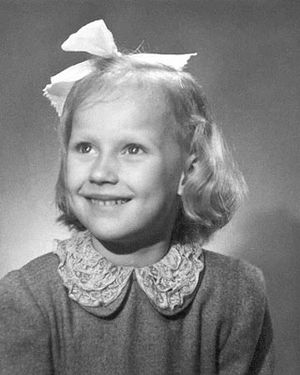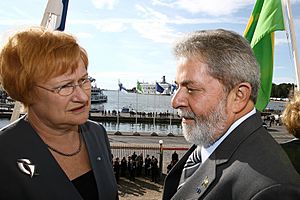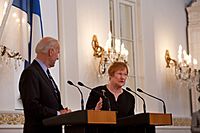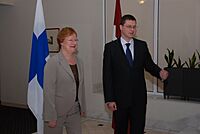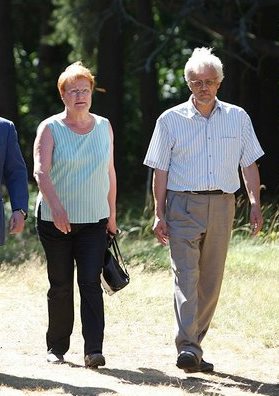Tarja Halonen facts for kids
Quick facts for kids
Tarja Halonen
|
|
|---|---|
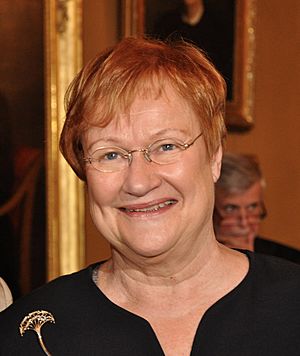
Halonen in 2011
|
|
| 11th President of Finland | |
| In office 1 March 2000 – 1 March 2012 |
|
| Prime Minister | Paavo Lipponen Anneli Jäätteenmäki Matti Vanhanen Mari Kiviniemi Jyrki Katainen |
| Preceded by | Martti Ahtisaari |
| Succeeded by | Sauli Niinistö |
| Minister of Foreign Affairs | |
| In office 13 April 1995 – 25 February 2000 |
|
| Prime Minister | Paavo Lipponen |
| Preceded by | Paavo Rantanen |
| Succeeded by | Erkki Tuomioja |
| Minister of Justice | |
| In office 28 February 1990 – 26 April 1991 |
|
| Prime Minister | Harri Holkeri |
| Preceded by | Matti Louekoski |
| Succeeded by | Hannele Pokka |
| Member of the Finnish Parliament | |
| In office 24 March 1979 – 29 February 2000 |
|
| Succeeded by | Ilkka Taipale |
| Constituency | Helsinki |
| Personal details | |
| Born |
Tarja Kaarina Halonen
24 December 1943 Helsinki, Finland |
| Political party | Social Democratic |
| Spouse |
Pentti Arajärvi
(m. 2000) |
| Children | Anna Halonen |
| Alma mater | University of Helsinki |
| Signature | |
Tarja Kaarina Halonen (born 24 December 1943) is a Finnish politician. She served as the 11th president of Finland from 2000 to 2012. She was the first woman to hold this important position.
Before becoming president, Halonen worked as a lawyer. She was also a member of the City Council of Helsinki and a Social Democratic Party member of parliament. She held several government roles, including Minister of Social Affairs and Health, Minister of Justice, and Minister for Foreign Affairs.
Tarja Halonen was a very popular president. Her approval ratings were very high during her time in office. She was re-elected in 2006 for a second term. She could not run for president again in 2012 because of term limits.
Halonen is known for caring about human rights. She supported women's rights and discussed global issues during her presidency. She was also mentioned as a possible candidate for the United Nations Secretary-General position. In 2009, Forbes magazine named her one of the most powerful women in the world.
She is part of the Council of Women World Leaders. This group brings together women who have been presidents or prime ministers. Their goal is to work together on important issues for women and fair development around the world.
Since the death of Martti Ahtisaari in 2023, Tarja Halonen is the oldest living former president of Finland.
Contents
Early Life and Education
Tarja Halonen was born on 24 December 1943 in Kallio, a working-class area in Helsinki. Her mother, Lyyli Elina Loimola, was a set-dresser. Her father, Vieno Olavi Halonen, worked as a welder. Her parents married during World War II.
When Tarja was two years old, her father left the family. Her parents officially divorced in 1948. In 1950, her mother married Thure Forss, an electrician who was active in the community. Both her mother and stepfather greatly influenced her views on life. Halonen later said her mother was strong and valued honest, hardworking people. She said these are the qualities she respects in others.
Tarja Halonen started school in Kallio. She finished high school in 1962. She began studying Art History at the University of Helsinki in 1962. In 1963, she changed her studies to law. She earned her Master of Laws degree in 1968, focusing on criminal law.
Before finishing her degree, she worked as a lawyer. From 1969 to 1970, she worked for the National Union of University Students in Finland. In 1970, she became the first woman lawyer at the Central Organisation of Finnish Trade Unions.
Political Journey: 1970–2000
Starting in Trade Unions
In 1971, Tarja Halonen joined the Social Democratic Party of Finland. This party had strong connections with the trade unions where she worked as a lawyer.
In the early 1970s, she was chosen to represent the Central Organisation of Finnish Trade Unions on a committee. This committee worked to recognize East Germany as a country. She later became the Vice-President of this committee.
First Steps in Politics
In 1974, Prime Minister Kalevi Sorsa chose Halonen to be his parliamentary secretary. This job made Halonen more interested in politics.
She decided to run in the local elections in 1976. She was elected to the City Council of Helsinki. She served on the council for five terms, from 1977 to 1996. In 1979, she was also elected to the Parliament of Finland for the Helsinki area. She served in Parliament until she became president in 2000. Her first main role in Parliament was as the chairman of the Social Committee, from 1984 to 1987.
Becoming a Minister
In 1987, Prime Minister Harri Holkeri appointed Halonen as Minister of Social Affairs and Health. She held this position until 1990. She also served as Minister for Nordic Cooperation from 1989 to 1991.
From 1990 to 1991, she was the Minister of Justice. Then, from 1995 until she was elected president, she served as the Minister of Foreign Affairs.
Presidential Campaigns
Running for President in 2000
Halonen announced in 1999 that she wanted to run for president in the 2000 elections. In her party's early elections, she won by a large number of votes. The current president, Martti Ahtisaari, decided not to run for a second term.
Halonen was a surprising candidate because she was known for her progressive views. She was also living with her partner and was a single parent. Despite starting in fourth place in the polls, she received the most votes (40.0%) in the first round of the election. Her closest opponent was Esko Aho.
Since no candidate received over 50% of the votes, a second round of voting was held. In this round, Halonen won by a small margin, with 51.6% of the votes. She became Finland's first female head of state. Her first term as president began on 1 March 2000.
Re-election in 2006
On 20 May 2005, Halonen announced she was willing to run for a second term. She had strong support from her own party and other groups.
American TV host Conan O'Brien made jokes about Halonen on his show because he looked like her. He even visited Finland and met her.
In the first round of the 2006 election, Halonen received 46% of the votes. Sauli Niinistö was second with 24%. They went to a second round on 29 January 2006. Halonen was re-elected with 51.8% of the vote, winning against Mr. Niinistö. It was a very close election.
Her Time as President
First Term: 2000–2006

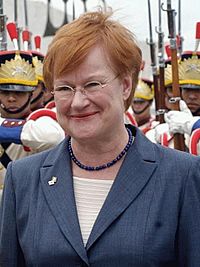
After her first election victory, Halonen's popularity grew. Her approval ratings reached a high of 88% in December 2003.
She spoke about her concerns regarding how Russia might react if Baltic countries joined NATO. She also opposed the use of landmines by the Finnish military.
Second Term: 2006–2012
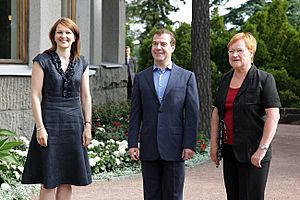
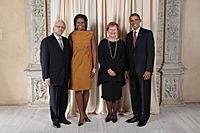
In 2008, Halonen made a choice for a government position that was different from what the government wanted. This led to some discussion.
In September 2008, some people felt Halonen's comments about Estonia were not polite. She had said Estonians suffered from a "post-Soviet stress condition." The President of Estonia, Toomas Hendrik Ilves, responded to her comments.
At the end of her second term, Halonen's presidency and economic ideas received some criticism.
Political Beliefs
Early in her career, Halonen was known for her progressive political views. She supported Finland's neutrality and good relations with the Soviet Union.
Throughout her political career, Halonen has said she supports "international solidarity." She describes herself as a "relative pacifist," meaning she does not support getting rid of all weapons without others doing the same. She strongly defended the President's role as the leader of the military. She was against Finland joining NATO during her time as president. However, after the 2022 Russian invasion of Ukraine, when Finland decided to apply for NATO membership, Halonen also supported the move. She called it "a necessary measure in the changed security situation in Europe."
Halonen has publicly supported the involvement of trade unions in politics.
In 2013, after her presidency, Halonen publicly supported same-sex marriage.
Personal Life
Halonen enjoys art history, theater, and swimming. She speaks Finnish, Swedish, and English. She has also been studying Estonian.
On 26 August 2000, Halonen married her longtime partner, Dr. Pentti Arajärvi. They had been together for over fifteen years. The wedding was a civil ceremony at her official home. Both Halonen's adult daughter, Anna, and Arajärvi's adult son, Esko, were witnesses. Both children are from previous relationships.
She often shows her Finnish pride by wearing things like a Moomin watch.
In the 1960s, she left the Evangelical Lutheran Church of Finland. This was to protest its policies at the time. After her presidential term, Halonen rejoined the Church.
From 1980 to 1981, Halonen was the chairman of Seta, a main organization for LGBT rights in Finland.
Key Roles and Positions
- Member of the Social Democratic Party 1971–2000
- Prime Minister's Parliamentary Secretary 1974–1975
- Member of Helsinki City Council 1977–1996
- Member of Parliament (Helsinki constituency) 1979–2000
- Minister of Social Affairs and Health 1987–1990
- Minister of Nordic Cooperation 1989–1991
- Minister of Justice 1990–1991
- Minister of Foreign Affairs 1995–2000
- President of Finland 2000–2012
Honours and Awards
| Coat of Arms of Tarja Halonen | |
|---|---|
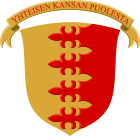 |
|
| Armiger | Tarja Halonen |
| Adopted | 2001 |
| Motto | "Yhteisen kansan puolesta"("For a united nation") |
National Honours
- Grand Master and Grand Cross of the Order of the Cross of Liberty
- Grand Master and Grand Cross with Collar of the Order of the White Rose
- Grand Master and Grand Cross of the Order of the Lion
Selected Foreign Honours
 Denmark: Knight of the Order of the Elephant
Denmark: Knight of the Order of the Elephant Estonia: Collar of the Order of the Cross of Terra Mariana
Estonia: Collar of the Order of the Cross of Terra Mariana France: Grand Cross of the Order of the Legion of Honour
France: Grand Cross of the Order of the Legion of Honour Germany: Grand Cross Special Class of the Order of Merit of the Federal Republic of Germany
Germany: Grand Cross Special Class of the Order of Merit of the Federal Republic of Germany Iceland: Grand Cross with Collar of the Order of the Falcon
Iceland: Grand Cross with Collar of the Order of the Falcon Italy: Knight Grand Cross with Collar of the Order of Merit of the Italian Republic
Italy: Knight Grand Cross with Collar of the Order of Merit of the Italian Republic Japan: Grand Cordon with Collar of the Order of the Chrysanthemum
Japan: Grand Cordon with Collar of the Order of the Chrysanthemum Norway: Grand Cross with Collar of the Order of St. Olav
Norway: Grand Cross with Collar of the Order of St. Olav Poland: Grand Cross of the Order of the White Eagle
Poland: Grand Cross of the Order of the White Eagle Sweden: Member with Collar of the Royal Order of the Seraphim
Sweden: Member with Collar of the Royal Order of the Seraphim
Honorary Degrees
Tarja Halonen has received many honorary degrees from universities around the world, including:
- University of Helsinki, Finland
- University of Tartu, Estonia
- University of Kent, United Kingdom
- University of Minnesota Duluth, United States
See also
 In Spanish: Tarja Halonen para niños
In Spanish: Tarja Halonen para niños
- List of national leaders
- List of presidents of Finland


